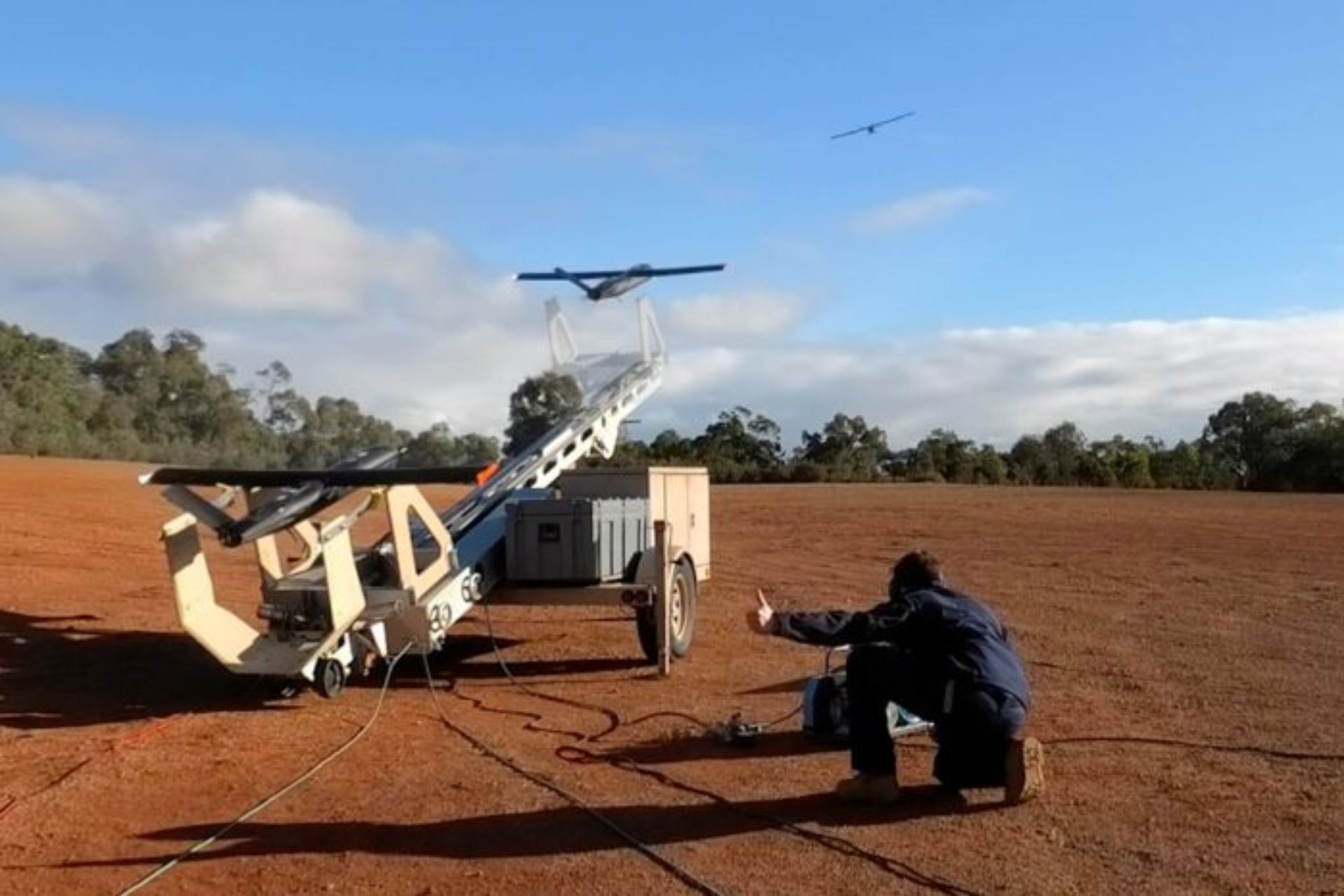Australia Backs Domestic Innovation with Mission Talon Strike to Develop Medium-Range Precision Loitering Munition

{loadposition bannertop}
{loadposition sidebarpub}
On May 19, 2025, the Australian government officially announced the launch of Mission Talon Strike, a technological initiative aimed at developing a sovereign capability in medium-range precision loitering munitions. Led by the Advanced Strategic Capabilities Accelerator (ASCA), this mission is part of a broader strategy by the Albanese government to equip Australian ground forces with systems capable of filling the capability gap between short- and long-range munitions. The goal is to provide the armed forces with an effective, mobile, locally manufactured strike solution, while minimizing costs and logistical burden.
Follow Army Recognition on Google News at this link
Innovaero’s OWL-B is launched from Insitu Pacific’s Mark 4 Launcher (Picture source: Innovaero )
To implement this objective, ASCA has issued a Request for Tender (RFT) to Australian industry and research organizations. An evaluation of proposals is expected to conclude by June 9, with deliveries to begin on June 20, according to the indicative schedule. This accelerated timeline reflects the strategic importance assigned to this capability, identified as a priority in the 2024 National Defence Strategy. The tender requirements are demanding: the system must be supported by a sovereign, modular, scalable, and cost-effective industrial supply chain.
In his accompanying letter to the tender, Major General Hugh Meggitt, Head of ASCA, emphasized that the agency’s mission is to accelerate the development and transition of asymmetric capabilities to the Australian Defence Force (ADF) through close collaboration with national industry and technological innovation. He noted that Mission Talon Strike aims to establish an initial baseline for integrated, demonstrated, and locally produced capabilities in medium-range precision loitering munitions launched from land.
This launch follows closely on the heels of Mission Syracuse, another ASCA initiative announced just days earlier. Mission Syracuse focuses on strengthening the ADF’s counter-drone capabilities through the development of advanced technologies to intercept small uncrewed aerial systems (UAS). These technologies are expected to integrate with existing counter-UAS (CsUAS) systems and will be procured through a two-stage process involving contributions from both industry and research institutions.
Major General Meggitt explained that in light of the rapid evolution of small drone threats, the government had instructed Defence to expedite the acquisition of counter-UAS capabilities. Mission Syracuse will support investment in advanced systems capable of deployment both domestically and internationally. It is also intended to complement the LAND 156 program, which aims to deliver a complete counter-UAS capability to the ADF based on a distributed, multi-layered architecture to detect, track, identify, and neutralize aerial threats.
In an official statement, Minister for Defence Industry Pat Conroy described Mission Talon Strike as a priority capability being developed at an accelerated pace. He recalled that this initiative continues three years of collaboration with the ADF to establish a domestic capability in precision loitering munitions that can address threats quickly and accurately. He noted that the mission reflects the Albanese government’s support for national industrial development and its commitment to addressing Defence’s operational requirements through domestic solutions.
These combined efforts, led by ASCA through Talon Strike, Syracuse, and the earlier Mission Black Thorn, which focused on degrading integrated air and missile defence systems of potential adversaries, illustrate a consistent approach to technological modernization. They also reflect an ambition to secure greater industrial autonomy in the context of rising geopolitical tensions and rapidly evolving military technologies.
According to forecasts by GlobalData, Australia’s defence budget, which stood at $37.8 billion in 2024, is projected to grow at an average annual rate of more than 6% between 2025 and 2029. This increase is largely driven by planned investments in aircraft, submarines, surface vessels, and missiles. Within this expanding budget, loitering munitions and counter-drone capabilities have emerged as strategic priorities for both operational readiness and national defence industry development.
Missions Talon Strike and Syracuse reflect a policy-driven effort to provide the ADF with advanced asymmetric capabilities while reinforcing Australia’s domestic defence industrial base. Through accelerated acquisition timelines, targeted innovation, and the pursuit of sovereign solutions, these initiatives underscore Australia’s intent to adapt to contemporary security challenges with effective, locally developed responses.

{loadposition bannertop}
{loadposition sidebarpub}
On May 19, 2025, the Australian government officially announced the launch of Mission Talon Strike, a technological initiative aimed at developing a sovereign capability in medium-range precision loitering munitions. Led by the Advanced Strategic Capabilities Accelerator (ASCA), this mission is part of a broader strategy by the Albanese government to equip Australian ground forces with systems capable of filling the capability gap between short- and long-range munitions. The goal is to provide the armed forces with an effective, mobile, locally manufactured strike solution, while minimizing costs and logistical burden.
Innovaero’s OWL-B is launched from Insitu Pacific’s Mark 4 Launcher (Picture source: Innovaero )
To implement this objective, ASCA has issued a Request for Tender (RFT) to Australian industry and research organizations. An evaluation of proposals is expected to conclude by June 9, with deliveries to begin on June 20, according to the indicative schedule. This accelerated timeline reflects the strategic importance assigned to this capability, identified as a priority in the 2024 National Defence Strategy. The tender requirements are demanding: the system must be supported by a sovereign, modular, scalable, and cost-effective industrial supply chain.
In his accompanying letter to the tender, Major General Hugh Meggitt, Head of ASCA, emphasized that the agency’s mission is to accelerate the development and transition of asymmetric capabilities to the Australian Defence Force (ADF) through close collaboration with national industry and technological innovation. He noted that Mission Talon Strike aims to establish an initial baseline for integrated, demonstrated, and locally produced capabilities in medium-range precision loitering munitions launched from land.
This launch follows closely on the heels of Mission Syracuse, another ASCA initiative announced just days earlier. Mission Syracuse focuses on strengthening the ADF’s counter-drone capabilities through the development of advanced technologies to intercept small uncrewed aerial systems (UAS). These technologies are expected to integrate with existing counter-UAS (CsUAS) systems and will be procured through a two-stage process involving contributions from both industry and research institutions.
Major General Meggitt explained that in light of the rapid evolution of small drone threats, the government had instructed Defence to expedite the acquisition of counter-UAS capabilities. Mission Syracuse will support investment in advanced systems capable of deployment both domestically and internationally. It is also intended to complement the LAND 156 program, which aims to deliver a complete counter-UAS capability to the ADF based on a distributed, multi-layered architecture to detect, track, identify, and neutralize aerial threats.
In an official statement, Minister for Defence Industry Pat Conroy described Mission Talon Strike as a priority capability being developed at an accelerated pace. He recalled that this initiative continues three years of collaboration with the ADF to establish a domestic capability in precision loitering munitions that can address threats quickly and accurately. He noted that the mission reflects the Albanese government’s support for national industrial development and its commitment to addressing Defence’s operational requirements through domestic solutions.
These combined efforts, led by ASCA through Talon Strike, Syracuse, and the earlier Mission Black Thorn, which focused on degrading integrated air and missile defence systems of potential adversaries, illustrate a consistent approach to technological modernization. They also reflect an ambition to secure greater industrial autonomy in the context of rising geopolitical tensions and rapidly evolving military technologies.
According to forecasts by GlobalData, Australia’s defence budget, which stood at $37.8 billion in 2024, is projected to grow at an average annual rate of more than 6% between 2025 and 2029. This increase is largely driven by planned investments in aircraft, submarines, surface vessels, and missiles. Within this expanding budget, loitering munitions and counter-drone capabilities have emerged as strategic priorities for both operational readiness and national defence industry development.
Missions Talon Strike and Syracuse reflect a policy-driven effort to provide the ADF with advanced asymmetric capabilities while reinforcing Australia’s domestic defence industrial base. Through accelerated acquisition timelines, targeted innovation, and the pursuit of sovereign solutions, these initiatives underscore Australia’s intent to adapt to contemporary security challenges with effective, locally developed responses.






